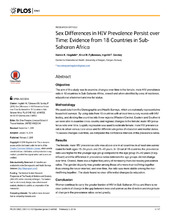| dc.contributor.author | Hegdahl, Hanne K. | en_US |
| dc.contributor.author | Fylkesnes, Knut | en_US |
| dc.contributor.author | Sandøy, Ingvild Fossgard | en_US |
| dc.date.accessioned | 2016-12-30T09:44:26Z | |
| dc.date.available | 2016-12-30T09:44:26Z | |
| dc.date.issued | 2016-02-03 | |
| dc.Published | PLoS ONE 2016, 11(2):e0148502 | eng |
| dc.identifier.issn | 1932-6203 | |
| dc.identifier.uri | https://hdl.handle.net/1956/15306 | |
| dc.description.abstract | Objective: The aim of this study was to examine changes over time in the female: male HIV prevalence ratio in 18 countries in Sub-Saharan Africa, overall and when stratified by area of residence, educational attainment and marital status. Methodology: We used data from the Demographic and Health Surveys, which are nationally representative household surveys. By using data from 18 countries with at least two survey rounds with HIV testing, and dividing the countries into three regions (Western/Central, Eastern and Southern) we were able to examine cross-country and regional changes in the female: male HIV prevalence ratio over time. Logistic regression was used to estimate female: male HIV prevalence ratios in urban versus rural areas and for different categories of education and marital status. To assess changes over time, we compared the confidence intervals of the prevalence ratios. Results: The female: male HIV prevalence ratio was above one in all countries in at least one survey round for both ages 15–24 years and 25–49 years. In 13 out of 18 countries the prevalence ratio was higher for the younger age group compared to the age group 25–49 years (3 significant) and this difference in prevalence ratios between the age groups did not change over time. Overall, there was a higher frequency of increasing than decreasing prevalence ratios. The gender disparity was greater among those who were married/living together than among the never-married, and over time, the ratio was more stable among the married/living together. The study found no clear differential changes by education. Conclusion: Women continue to carry the greater burden of HIV in Sub-Saharan Africa and there is no clear pattern of change in the gap between men and women as the direction and magnitude of change in the prevalence ratios varied greatly. | en_US |
| dc.language.iso | eng | eng |
| dc.publisher | PLOS | eng |
| dc.rights | Attribution CC BY | eng |
| dc.rights.uri | http://creativecommons.org/licenses/by/4.0/ | eng |
| dc.title | Sex differences in HIV prevalence persist over time: Evidence from 18 countries in Sub-Saharan Africa | en_US |
| dc.type | Peer reviewed | |
| dc.type | Journal article | |
| dc.date.updated | 2016-12-13T13:47:49Z | |
| dc.description.version | publishedVersion | en_US |
| dc.rights.holder | Copyright 2016 The Author(s) | |
| dc.identifier.doi | https://doi.org/10.1371/journal.pone.0148502 | |
| dc.identifier.cristin | 1409445 | |

